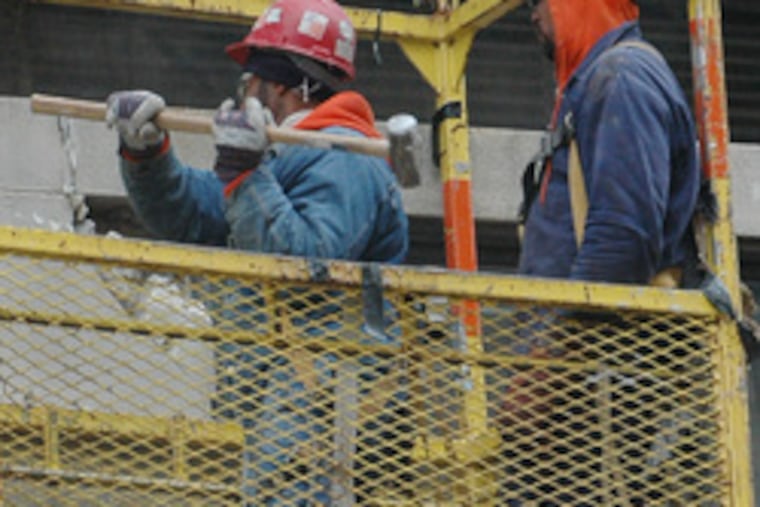Ruling aside, center razing 2 buildings
Preservationists, who thought the historic sites safe, were angry.

INQUIRER ARCHITECTURE CRITIC
The state agency overseeing the expansion of the Pennsylvania Convention Center yesterday began tearing off the facades of two historic buildings on North Broad Street in defiance of a protection ruling issued Thursday by the state's top preservation official.
The demolition, which began at 6:30 a.m. and by midday had produced a waist-high pile of broken limestone, sent shock waves through Philadelphia's preservation community, which was still celebrating Thursday's action by the Pennsylvania Historical and Museum Commission. They believed that the commission's two-page ruling amounted to a legal reprieve and would stop the Convention Center's bulldozers from reaching Broad Street.
But an official close to Gov. Rendell insisted that the commission's ruling was "only an opinion" and not binding on the center.
"We have no intention of leaving those buildings," added the official, who asked not to be identified.
"I don't get it," said Alan Greenberger, chairman of the Design Advocacy Group, which campaigned with Philadelphia's Preservation Alliance to save the historic structures, between Arch and Cherry Streets. "We, as architects, have never been able to say, 'That's just PHMC's opinion, and we'll ignore it.' "
The remaining bones of the conjoined buildings - the former headquarters of the Philadelphia Life Insurance Co. - will be completely demolished in the next several days, said Edward Myslewicz, spokesman for the Department of General Services (DGS), the agency that coordinates state construction projects. The modernist masterpiece from 1962 by renowned Philadelphia School architect Romaldo Giurgola and an ornately carved early 20th-century commercial building were supposed to be incorporated into the Convention Center's new Broad Street facade.
That arrangement was the result of a compromise enshrined in a 2004 legal agreement between the Convention Center Authority and the state historical commission, headed by Barbara Franco. Although several important historic buildings were in the path of expansion, the commission permitted their demolition on the condition that the critical block of Broad Street just north of City Hall be left intact.
Nearly all the historic buildings in the two-block expansion zone are now gone, with the exception of the beloved Race Street firehouse, adorned with gargoyles in firefighting gear.
Greenberger called the demolition "an outrageous breach of trust," and added, "To do it on the Saturday before Christmas, when no one is looking, is despicable."
It was not clear why DGS chose yesterday - a day when work crews normally receive overtime pay - to start demolition, particularly since the agency has been in discussions over the buildings' fate since August. No one from the historical commission was available for comment yesterday.
But it appears that the final decision on demolition was made only on Friday, one day after the commission took a strong stand in favor of retaining the buildings.
The head of the demolition workers, who gave only his first name, Pat, said their boss, Geppert Bros., had not asked them to work yesterday until Friday.
In her Thursday letter, commission director Franco rejected the DGS assertion that the buildings were structurally compromised or beyond repair. She quoted the Convention Center's own architects - Emmanuel Kelly of Kelly/Maiello and Richard Holland of Vitetta - as saying the structures were sound enough to be knitted into the center's new glass facade.
"We therefore conclude that there is no reason to amend the current Memorandum of Agreement," she wrote, referring to the 2004 contract with the Convention Center.
But on Friday, DGS shot back with its own letter to Franco. The agency said that incorporating the two buildings into the new facade would be too expensive, and that a Convention Center architect, Hy Myers of Vitetta, a noted preservation architect, had "strongly recommended the demolition."
Myslewicz said that because the 2004 contract had been signed by the Convention Center Authority, not DGS, "it was viewed as a nonbinding agreement."
Greenberger warned that the demoliton could seriously erode the credibility of the state historical commission and other agencies.
"Why should anybody now trust a deal made with a public agency on historic preservation?" he asked. "They don't honor deals. That's the message of all this."
The Giurgola structure is the second of the architect's buildings to go down in Philadelphia. Last year, the National Park Service dismantled his jaunty Liberty Bell pavilion on Independence Mall, built for the Bicentennial. Giurgola, who now lives in Australia, was one of three or four internationally famous architects who made Philadelphia a hotbed of design in the 1960s and '70s.
His 1962 addition to Philadelphia Life Insurance's Broad Street headquarters was immediately hailed as a step forward for modernism because it demonstrated how contemporary design could accommodate itself to the traditional scale and masonry materials of old Philadelphia without sacrificing its own personality.